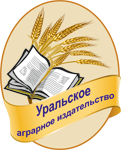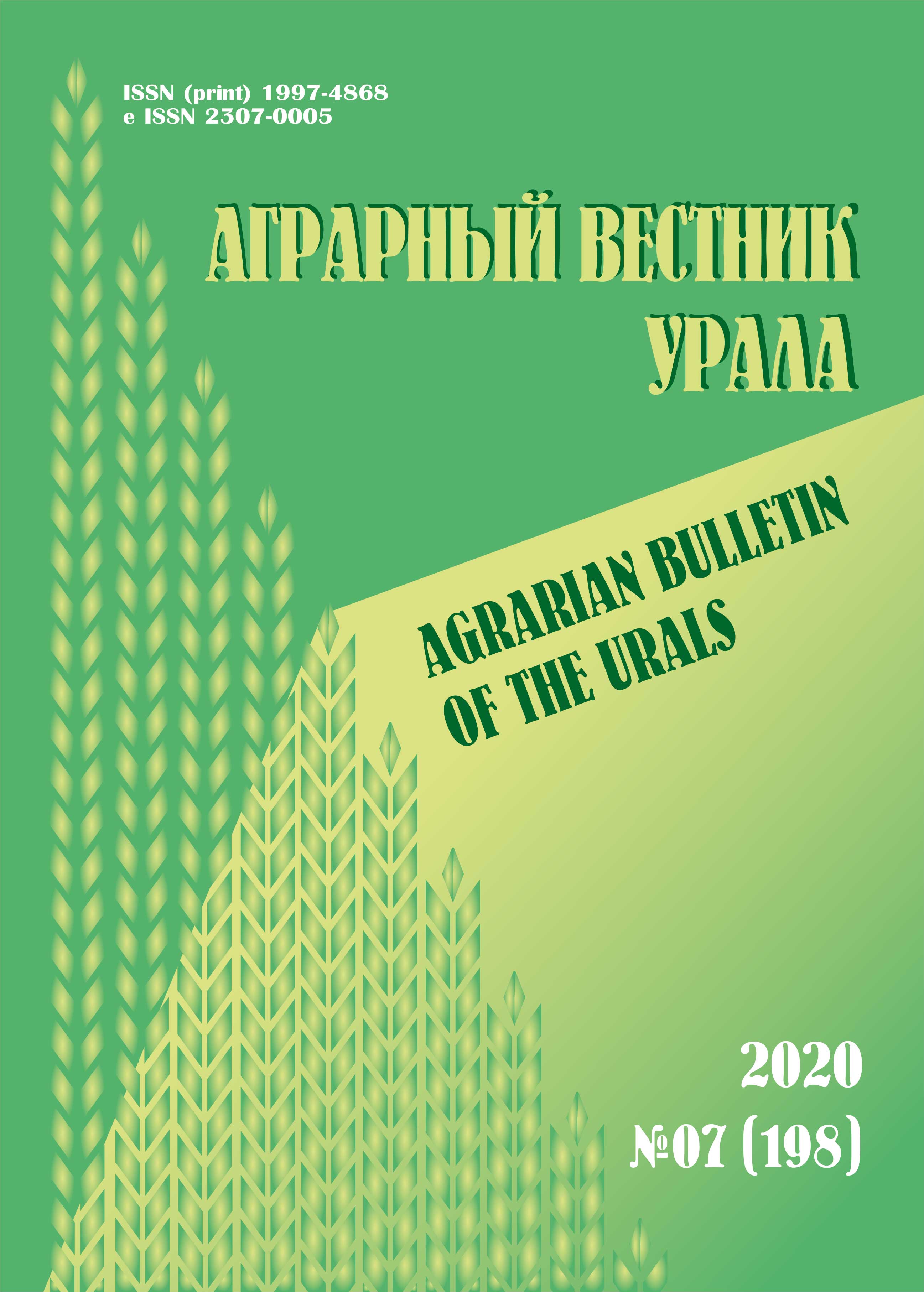Russian Federation
Abstract. The study is aimed at studying the effect of the probiotic strain Bifidobacterium longum on the content of chemical elements in the biological tissues of broiler chickens against the background of a mineral-deficient diet. Methods. The research was conducted on cross Arbor-Icers broiler chickens between the ages of 7 and 42 days old. From the 21-day-old age of chickens, two groups of 15 heads each were formed by the method of analogs, the studied bird was kept on a mineral-deficient diet. Poultry of the experimental group received a liquid probiotic preparation “Soy-bifidum” in a dosage of 0.7 ml/kg of feed. Features of the exchange of chemical elements were determined by studying the content of the elemental composition of the liver, thoracic and femoral muscles on 25 indicators. Results and practical significance. The additional inclusion of the probiotic strain in the diet contributes to the maximum elimination of toxic elements, thereby reducing the intoxication of the entire body. Thus, the probiotic strain Bifidobacterium longum contributed to a significant decrease of aluminium in the liver by on 34 % (p = 0.048), lead – 50 % (p = 0.008), tin – 67 % (p = 0.0064), aluminium in the thoracic muscles by 54.6 % (p = 0.005), and cadmium by 55.6 % (p = 0.005), cadmium in the femoral muscles by 50 % (p = 0.006), lead by 75 % (p = 0.001), strontium – 50 % (p = 0.013) compared to such values in the control group. Scientific novelty. There were described the features of elemental metabolism by 25 indicators of broiler chickens with the introduction of probiotic drugs against the background of a mineral-deficient diet for the first time.
probiotic, broiler chickens, toxic elements, deficient diet
1. Garg N., Abdel-Aziz S., Aeron A. Microbes in food and health // Springer International Publishing. 2016. No. 1. R. 362. DOI:https://doi.org/10.1007/978-3-319-25277-3.
2. Lu L., Liao X., Luo X. Nutritional strategies for reducing nitrogen, phosphorus and trace mineral excretions of livestock and poultry // Journal of Integrative Agriculture. 2017. No. 16 (12). Pp. 2815-2833. DOI:https://doi.org/10.1016/S2095-3119(17)61701-5.
3. He Y., Chen Z., Liu X. Influence of trace elements mixture on bacterial diversity and fermentation characteristics of liquid diet fermented with probiotics under air-tight condition // PLoS ONE. 2014. No. 9 (12). DOI:https://doi.org/10.1371/journal.pone.0114218.
4. Khan R., Rahman Z., Javed I., Muhammad F. Serum antioxidants and trace minerals as influenced by vitamins, probiotics and proteins in broiler breeders // Journal of Applied Animal Research. 2014. No. 42 (3). Pp. 249-255. DOI:https://doi.org/10.1080/09712119.2013.822815.
5. Feng P. et al. A review on gut remediation of selected environmental contaminants: Possible roles of probiotics and gut microbiota // Nutrients. 2019. No. 11. DOI:https://doi.org/10.3390/nu11010022.
6. Musawi A. M., et al. The growth potential and bioaccumulation ability of probiotics under the exposure of different heavy metals // Pertanika Journal of Tropical Agricultural Science. 2019. No. 42. Pp. 305-314.
7. Zhai Q., Narbad A., Chen W. Dietary strategies for the treatment of cadmium and lead toxicity // Nutrients. 2015. No. 7. Pp. 552-571.
8. Foligné B. Probiotics and heavy metals. Journal of Pediatric // Gastroenterology & Nutrition. 2016. No. 63. P. 42.
9. Miroshnikov S., Kvan O., Duskaev G., Rusakova E., Davydova N. Endogenous losses of chemical elements in the digestive tract and their correction // Modern Applied Science. 2015. No. 9 (9). Pp. 72-79. EDN: https://elibrary.ru/UENTUN
10. Kvan O., Gavrish I., Lebedev S., Korotkova A., Miroshnikova E., Bykov A., Serdaeva V., Davydova N. Effect of probiotics on the basis of Bacillus subtilis and Bifidobacterium longum on the biochemical parameters of the animal organism // Environmental Science and Pollution Research. 2018. No. 25 (3). Pp. 2175-2183.
11. Order No. 755 on 12.08.1977 the USSR Ministry of Health
12. National Academy Press Washington, D.S. 1966
13. Deryabina D. G., Efremova L. V., Karimov I. F., Manukhov I. V., Gnuchikh E. Y., Miroshnikov S. A. Comparative Sensitivity of the Luminescent Photobacterium phosphoreum, Escherichia coli, and Bacillus subtilis Strains to Toxic Effects of Carbon-Based Nanomaterials and Metal Nanoparticles // Microbiology. 2016. No. 85 (2). Pp. 177-186.
14. Boyaval P. Lactic acid bacteria and metal ions // Dairy Science & Technology. 1989. No. 2. Pp. 87-113.
15. Ravindran V. Feed-induced specific ileal endogenous amino acid losses: Measurement and significance in the protein nutrition of monogastric animals // Animal Feed Science and Technology. 2016. No. 221. Pp. 304-313. DOI:https://doi.org/10.1016/j.anifeedsci.2016.05.013.
16. Cerrate S., Vignale S. K., Ekmay R., England J., Coon C. Effect of dietary nutrients on ileal endogenous losses of threonine, cysteine, methionine, lysine, leucine and protein in broiler chicks // Animal. 2018. No. 12 (4). Pp. 684-691. DOI:https://doi.org/10.1017/S1751731117002166.
17. Cowieson, A. J., Acamovic, T., Bedford, M. R. The effects of phytase and phytic acid on the loss of endogenous amino acids and minerals from broiler chickens // British Poultry Science. 2004. No. 45 (1). Pp. 101-108. DOI:https://doi.org/10.1080/00071660410001668923.
18. Adeola O., Xue P. C., Cowieson A. J., Ajuwon K. M. Basal endogenous losses of amino acids in protein nutrition research for swine and poultry // Animal Feed Science and Technology. 2016. No. 221. Pp. 274-283. DOI:https://doi.org/10.1016/j.anifeedsci.2016.06.004.
19. Schweer W. P., Patience J. F., Burrough E. R., Kerr B. J., Gabler N. K. Impact of PRRSV infection and dietary soybean meal on ileal amino acid digestibility and endogenous amino acid losses in growing pigs // Journal of Animal Science. 2018. No. 96 (5). Pp. 1846-1859. DOI:https://doi.org/10.1093/j.as/sky093.
20. Starck C. S., Wolfe R. R., Moughan P. J. Endogenous Amino Acid Losses from the Gastrointestinal Tract of the Adult Human - A Quantitative Model // Journal of Nutrition. 2018. No. 148 (11). Pp. 1871-1881. DOI:https://doi.org/10.1093/jn/nxy162.
21. Bikker P., Van Der Peet-Schwering C. M. C., Gerrits W. J. J., Sips V., Walvoort C., Van Laar H. Endogenous phosphorus losses in growing-finishing pigs and gestating sows // Journal of Animal Science. 2017. No. 95 (4). Pp. 1637-1643. DOI:https://doi.org/10.2527/jas2016.1041.
22. Chen Y., Wang Z., Ding J., Ming D., Wang W., Jiang Z., Wang F. Effects of dietary fiber content and different fiber-rich ingredients on endogenous loss of fat and fatty acids in growing pigs // Journal of Animal Science and Biotechnology. 2019. No. 10 (1). DOI:https://doi.org/10.1186/s40104-019-0348-3. EDN: https://elibrary.ru/UOOZZW
23. Nyachoti C. M., De Lange C. F. M., McBride B. W., Schulze H. Significance of endogenous gut nitrogen losses in the nutrition of growing pigs: A review // Canadian Journal of Animal Science. 1997. No. 77 (1). Pp. 149-163. DOI:https://doi.org/10.4141/A96-044.
24. Ouwehand A. C., Forssten S., Hibberd A. A., Lyra A., Stahl B. Probiotic approach to prevent antibiotic resistance // Ann Med. 2016. No. 48 (4). Pp. 246-55. DOI:https://doi.org/10.3109/07853890.2016.1161232.
25. Nandi et al Probiotics and antimicrobial Proteins. 2017. No. 10. Pp. 391-398.
26. Podolian J. Effect of probiotics on the chemical, mineral, and amino acid composition of broiler chicken meat // Ukrainian Journal of Ecology. 2017. No. 7 (1). Pp. 61-65. DOI:https://doi.org/10.15421/20178.
27. Erdogan Z., Erdogan S., Aslantas O. Effects of dietary supplementation of synbiotics and phytobiotics on performance, caecal coliform population and some oxidant/antioxidant parameters of broilers // The Journal of Animal Physiology and Animal Nutrition. 2010. No. 94 (5). Pp. 40-48.
28. Contreras H., Chim N., Credali A., Goulding C. W. Heme uptake in bacterial pathogens // Current Opinion in Chemical Biology. 2014. No. 34-41. DOI:https://doi.org/10.1016/j.cbpa.2013.12.014.









